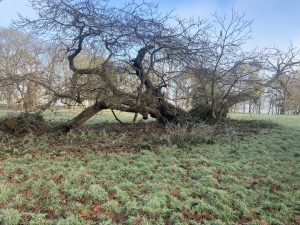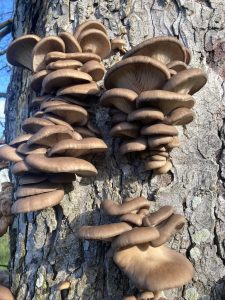Ancient and veteran tree habitat survey in Norfolk
WFE was fortunate enough to be asked to evaluate the fantastic collection of ancient and veteran trees at Heydon Hall in Norfolk; part of a wider piece of work to put together a Parkland Management Plan. Of the 600+ individual trees scattered in grassland or grouped together in avenues, just over 60 were identified as ancient or veteran. WFE undertook an ancient tree survey using the Specialist Survey Method to determine the diversity of fungi, epiphytes (lichens, mosses, climbers), invertebrates, birds and mammals supported by the tree.
A diversity of fungi were identified, with each tree on average supporting 4.5 fungi species including heartwood rotters such as Chicken-of-the-Woods Laetiporus sulphureus, skin like coverings on standing deadwood such a Peniophora quercina and even microfungi growing on lichens such as Illiosporopsis christiansenii.
Lichens and moss were abundant, with each tree supporting on average 10 lichen species and 2 moss species with several identifications of possible veteran specialist lichens. Many of the veteran and ancient trees had moderate or high potential for roosting bats – an important consideration in the planning of any tree work as part of future parkland management.
WFE also undertook an extended Phase 1 Habitat Survey of the entire parkland. Taking the ancient and veteran tree survey and ecological information together, advice was then provided on how best to manage the parkland for biodiversity. Focusing in particular on how to protect and enhance the existing valuable features such as the open grown trees, grasslands, ponds and woodland.
WFE’s combined ecological and arboricultural expertise were very useful for this project. A comprehensive report on our findings and advice for both trees and ecology was produced. We are excited to see how this feeds into a new Parkland Management Plan and benefits biodiversity in the Parkland going forward.


